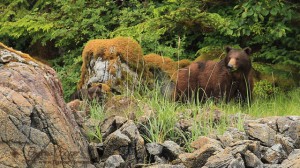Any wildlife photographer knows that getting The Shot is all about planning and patience, and perhaps a little luck. Not much we can do about the luck part, sometimes the bear just walks away. But there are ways to improve the first two items.

A mother brown bear (Ursus arctos horribilis) and cub along the shoreline of Long Bay, photo by Andrew Cooper
Traveling aboard a vessel like the Nordic Quest is an ideal way to explore these wilds with a camera. The boat is the perfect solution for many of the issues that face a photographer in the field. The Nordic Quest offers great logistical support. Both AC and DC power are available to run laptops and recharge camera batteries. You can sit in comfort, out of the bugs and rain while reviewing the photos of the day or planning where to move to next.
Planning is critical for a successful voyage. Researching where to go and when to be there will allow a photographer to make the best use their time. A little effort here can reap big rewards. Remember to keep the plan flexible, this will allow you to work around poor weather and photographic conditions.
Keep in mind that certain popular locations do require advance reservations for access. Glacier Bay National park limits the number of vessels that enter each day. They require reservations be obtained well ahead of time for the popular summer months. The famous Pack Creek bear viewing area likewise requires advance reservations. Without reservations there are always alternatives… If you do not have reservations for Glacier Bay, the spectacular Tracy Arm is always open for access.
To a photographer used to traveling the lower 48, the sheer density of wildlife in Alaska is an unexpected bounty. Imagine floating amongst several pods of feeding humpback whales. There are blows on every point of the compass, you hardly know where to aim the camera. We have had humpbacks off starboard and orca to port at the same time.
When we travel, there is always a camera sitting on the bridge for the unexpected. It does not matter who’s camera it is. There are standing instructions for whomever is manning the bridge… If you see anything interesting… Shoot it. If in doubt… Shoot it. It is just a few bytes on a card that can be deleted later.
There is some concern for safety when a photographic opportunity suddenly presents itself. The impulse is to grab the camera and go. This is one of those times that the camera strap becomes important. Be sure to put it over your head before stepping out on deck. Keep yourself safe as well, move a little more slowly, keep a hand on the rail, perhaps wear a flotation device. No need to take that very cold swim and risk hypothermia.
The 42′ Nordic Tug’s hull design allows 360° access around the boat, with decks running down the length of each side. This provides quick access to both the bow and stern. On the bow you will find a large bench, an ideal place to sit, camera in hand, and await the next blow of a whale surfacing. On top of the salon, safely accessible from an aft deck ladder, you have a large deck that provides a vantage point ten feet above the water line.
The boat is large enough to become a stable platform for shooting with a telephoto lens or video camera. A tripod setup on the deck is quite functional as 19 tons of fiberglass and steel has a fairly good dampening effect. There is the usual roll and drift with the normal motion of the boat, but the high frequency jitter, so problematic when shooting video, is gone.
The 10 foot tender, easily launched using a hydraulically operated davit, allows access to shore, shallow water, and can be taken up small rivers. Care must be taken when transporting camera gear in the tender, as it is very easy for salt water to come splashing over the bow when under way. Waterproof or splash-proof cases or dry bags are an excellent solution here.
With no tour schedule to keep, you can stay where the photo is as long as it takes to get it. You can spend hours drifting off Point Adolphus waiting for a whale to breach or setup another bubble net. You can wait for the tide to bring the salmon into a creek and for the bears to meander out onto the flats of any number of small bays. Or you can shoot a myriad of shots of colorful icebergs drifting slowly from the face of a glacier.
Another thing to remember is to take pictures of the mundane. Cooking dinner, making port, simply cruising along. It is odd how some of the best photos are taken in the quiet moments. Amongst 300 photos of whales will be one of yourself or a loved one, that will be a photo to be treasured. The journey will be a voyage to remember, and you will have the photographs to prove it.
